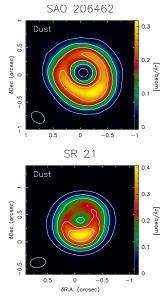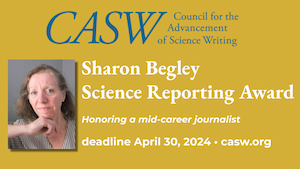By Jesse Mixson
CHICAGO — Radio may have killed the video star, but now it is helping astronomers fill in significant gaps in their understanding of how planets grow.
Young stars lie embedded within thick whirls of gas and dust, often called protoplanetary disks. Dust makes up a mere 1 percent of the mass of these disks, but that's still enough to form clouds and block telescopes from seeing how planets might start to form. Now, advances in astronomical radio telescopes promise to provide much deeper and sharper views of embryonic planets, scientists said during a symposium at the American Association for the Advancement of Science meeting in Chicago on Feb. 14.
All planets, from rocks like Mercury to gas giants like Jupiter, begin as microscopic specks of dust. Johnathan Williams, an astronomer at the University of Hawaii's Institute for Astronomy, gave some perspective on the extreme changes in scale that give rise to planets. Put simply, it’s like taking a molecule from a plume of smoke, then growing it as large as a grain of sand. That growth spans three orders of magnitude in size. But to go from dust specks in a protoplanetary disk to a planet, Williams said, crosses a dozen orders of magnitude.
Laura Pérez, a Jansky Fellow with the National Radio Astronomy Observatory (NRAO) in Socorro, New Mexico, said the biggest mysteries lie in the middle range of this dramatic growth. Astronomers have a good understanding of how the littlest dust specks clump together, but once the particles grow past a millimeter in size, the picture starts getting fuzzy.
“We are standing on a planet, so the problem must have been solved,” she said with a laugh.
Powerful observatories like the newly dedicated Atacama Large Millimeter/submillimeter Array (ALMA) in Chile and the refurbished Karl G. Jansky Very Large Array (VLA) in New Mexico are beginning to show how. These telescopes peer more deeply than ever through dust and gas with radio waves, collecting the faint signals using many large telescope dishes.
Inside the disks, the interaction between gas and dust is critical. Dust particles can grow up to a few centimeters across. Once they reach that size, gravity attracts them into a flattened plane of "pebbles" orbiting the young star. The gas in the disk relentlessly drags on these pebbles, forcing them into smaller and smaller orbits.
This process, called radial drift, means the stars can lose the planetary building blocks in their disks by dragging pebbles into the star itself. Further, collisions between pebbles can break them apart before they are big enough to start absorbing material on their own via gravity. This could happen long before particles ever reach the size of "planetesimals" (think tiny baby planets).
There are several ways to overcome these problems, Pérez said.
For instance, ALMA researchers are studying whether the dust in young stellar disks might orbit stars in uneven clumps. Lopsided rings of dust, recently observed by the telescope, may act as orbiting safe havens in which pebbles can grow.
New ALMA studies of two other stars by Pérez and her colleagues at NRAO and the California Institute of Technology also point to a dusty "vortex" in each star's disk — possible signs of planetary nurseries.
“Results from ALMA are really pouring in from different investigators all over the world,” Pérez said. The telescope's higher resolution is “bringing a revolution” to unveiling the hidden physics of gas and dust deep inside protoplanetary disks, she added.
Jesse Mixson is a senior at the University of Florida majoring in journalism. Her work has appeared in the Council for the Advancement of Science Writing’s New Horizons Newsroom and UF’s research magazine Explore. She is currently a student supervising editor at the Innovation News Center at UF. Follow her on Twitter @ntkos.

.png)

